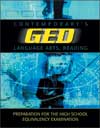|
 |  Contemporary's GED Language Arts, Reading John M. Reier
Synthesis
Chapter OutlineStudy the chapter outline below. Use the page numbers below each topic to refer to the corresponding section in Contemporary's GED Language Arts, Reading. When you are finished, go to the Flashcards or choose a different activity or chapter from the menu on the left.
Synthesis
(See page 89)
Synthesis is a reasoning process that draws multiple inferences from an entire passage or integrates information from outside the passage to reach a new understanding. |
|
|



 2002 McGraw-Hill Higher Education
2002 McGraw-Hill Higher Education